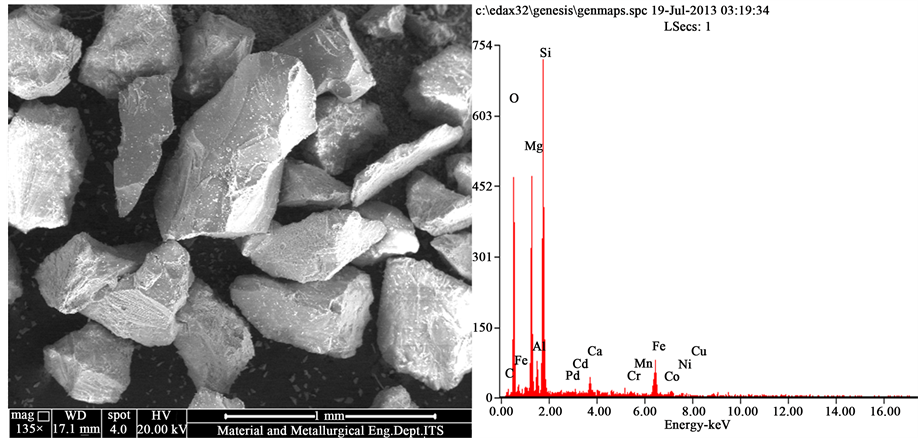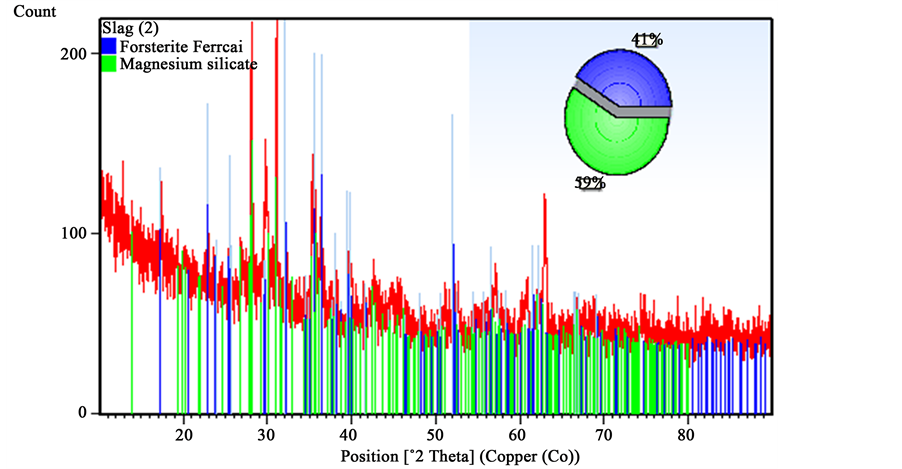Advances in Chemical Engineering and Science
Vol.05 No.03(2015), Article ID:58373,4 pages
10.4236/aces.2015.53041
Ferronickel Slag Performance from Reclamation Area in Pomalaa, Southeast Sulawesi, Indonesia
Bieby Voijant Tangahu1, IDAA Warmadewanthi1, Dian Saptarini2, Lily Pudjiastuti3, Mas Agus Mardyanto Tardan1, Arif Luqman1
1Department of Environmental Engineering, Institut Teknologi Sepuluh Nopember, Surabaya, Indonesia
2Department of Biology, Institut Teknologi Sepuluh Nopember, Surabaya, Indonesia
3Department of Chemical Engineering, Institut Teknologi Sepuluh Nopember, Surabaya, Indonesia
Email: voijant@its.ac.id
Copyright © 2015 by authors and Scientific Research Publishing Inc.
This work is licensed under the Creative Commons Attribution International License (CC BY).
http://creativecommons.org/licenses/by/4.0/



Received 30 June 2015; accepted 24 July 2015; published 28 July 2015
ABSTRACT
This study aimed to assess the differences of characteristics between the new ferronickel slag generated from the production of nickel and the slag which had been used as a material reclamation. The Toxicity Characteristic Leaching Procedure (TCLP) test was conducted on ferronickel slag to determine the concentration of heavy metals leaching. Then, the tests of X-Ray Diffraction (XRD), Scanning Electron Microscopic (SEM) and Energy-Dispersive X-Ray Spectroscopy (EDX) are also conducted on the ferronickel slag samples. The results of TCLP test show that the new ferronickel slag samples contain Fe (158, 6775 ppm), Cr (0.64465 ppm), and Pb (0.0219 ppm), and that the ferronickel slag has been used as a reclamation material containing Fe (3.94 ppm) and Cr (2.91 ppm). The result of EDX test shows that the slag sample from the reclamation area contains higher Ni concentration than the new slag sample. Slag that has been used for reclamation contains high SiO2 and Mg2(SiO6). The XRD analysis result shows that the highest elements in the slag are Si and Mg with 18.94% and 15.83% respectively. The dominant mineral in the slag is forsterite (Mg 1.784 FeSiO4 0216) by 41% and the rest is magnesium silicate (Mg2(Si2O6)).
Keywords:
EDX, SEM, Ferronickel Slag, XRD

1. Introduction
Industrial process of nickel ore into ferronickel produces slag as a by-product. The percentage of slag generated in the processing of nickel ore can reach 50% - 75% [1] . The study of Demotica et al. [2] mentions that the content of the slag in Illigan City, Philippines contains dominant mineral forsterite in the slag. The dominant mineral and slag structure may differently depend on each type of industry.
On Illigan Bay, Philippines, the ferronickel slag has been used as a material for the reclamation of 20 hectares [2] . In the Illawarra and Newcastle, Australia, slag also has been applied to many fields of infrastructure as a substitute for cement in several years [3] . In addition, in Pomalaa, Southeast Sulawesi, ferronickel slag has also been used as a material reclamation since around year of 1970s. In this study, the characteristic of the slag that has been used as sreclamation material is observed to compare with the new slag.
2. Research Methods
2.1. Analysis of TCLP
The method used is USEPA Method 1311. A hundred grams of ferronickel slag sample put in the 2.2 L HDPE (high density polyethylene) extraction vessel. Then 2 L of extraction solution was added with Liquid/solid ratio was 20 L/kg. The mixture then stirred for 18 + 2 hours in the rotary extractor and then the sample was filterred in glass fiber filter using a filter size of 0.7 lm. Then added 1 N HNO into the filtrate to achieve a pH < 2. Analyze the heavy metal component of the filtrate for elements of Fe, Cr, and Pb using Inductivvely Couple Plasma (ICP) analyzer.
2.2. Analysis of SEM
Macro and microstructure analysis was performed using scanning electron microscopy (SEM JEOL JSM- 6510LA). The 20 grams of samples were dried to remove the water content, and then crushed sputtering with carbon before analyzed with SEM analyzer.
2.3. XRD Analysis
The 20 grams of samples were dried and crushed, then analyze the minerals component in the slag using X-Ray Diffraction (XRD) analyzer and then compared with the standard software Mineral Database from the International Centre for Diffraction Data (ICDD) to determine the type of minerals in the slag.
2.4. EDX Analysis
The EDX analysis is to determine the chemical composition of the slag. 20 grams were crushed and analyzed.
3. Results and Discussion
3.1. Analysis of TCLP Test Results
The TCLP test is conducted to determine the leaching characteristic of slag, which is leaching is one of characteristic of hazardous material. In the TCLP test, the measured heavy metals are Fe, Cr, Cu, Pb, and Cd with the concentration of Fe, Cr and Pb are 6775 ppm, 0.64465 ppm, 0.0219 respectively, which Cu and Cd are not detected (Table 1). The content of heavy metals Cr TCLP exceeded the quality standard based on Indonesia Government Regulation No. 18 of the year 1999, which states that the maximum levels of Cr in the waste extracted is 0.25 ppm.
Table 1. Comparison of metals between slag TCLP test results and quality standards.
3.2. Slag Characteristics
Slag characteristics in this study were tested to determine the elements contained in the microscopic structure of the slag. This analysis is very important to know the physical and chemical characteristics of the slag. The results of SEM and EDX are shown in Figure 1, it can be seen that the highest element in the slag are Si and Mg with percentages of 18.94% and 15.83% respectively, followed by Fe and Ni, each with percentage of 5.84% and 0.014% respectively. Toxic heavy metals such as Cu, Cr, Pb and Co are in a very small percentage. Even Pb is not detected in the slag samples.
In contrast, the test results of the slag sample from the reclamation area which is mixed with the soil around the site is contained with higher concentration of Fe and Ni than the slag on top (Figure 2).
These results also prove that the soil around the site is contained with Ni in high concentration. The percentage of Ni in the sample of new slag is much lower compare with slag sample from reclamation area which is mix with soil. The previous study of Demotica et al. (2012) that examined the ferronickel slag in Iligan City, Philippines found that the slag composition were contained with high of Si, Mg and Al.

Figure1. The results of SEM and EDX tests of the new slag sample.

Figure 2. The results of SEM and EDX tests of the slag sample from reclamation area.
The XRD analysis was conducted to examine the dominant minerals present in the slag. The result shows that the dominant mineral present in the slag is forsterite (Mg 1.784 Fe 0216 SiO4) and magnesium silicate (Mg2(Si2O6). The forsterite in the mineral is 41% while the rest is magnesium silicate. This result is similar to the study conducted by Demotica et al. (2012), that the dominant mineral in the slag is forsterite. The presence of high Si in the slag is made the slag very strong and bonded with calcium-based mineral (Rasio 1/2H2O4) and with this characteristic the slag can be used for material in carbonication mineral element that is used to absorb carbon. The XRD results for new slag sample is shown in Figure 3, while the XRD result of slag sample from reclamation area is shown in Figure 4.
Slag sample from reclamation area is contain with high percentage of SiO2 and Mg2(SiO6). This because the slag has been mixed with the soil in the area of reclamation and the most major minerals in the soil is SiO2.

Figure 3. The results of XRD test of the new slag sample.

Figure 4. The results of XRD test of the slag sample from reclamation area.
4. Conclusions
The conclusions of this study:
1) The TCLP test results showed that metal content of the new slag sample contained Fe 6775 ppm, Cr 0.64465 ppm and Pb 0.0219 ppm. Cu and Cd were not detected. While the results of the CTLP test showed that the slag sample from reclamation area was contained with 3.94 ppm of Fe and 2.91 ppm of Cr, since the Pb, Cu, and Cd were not detected. The concentration of Cr was exceeded the quality standard TCLP based on Indonesia Government Regulation No. 18 the year of 1999. (PP no. 18 tahun 1999).
2) The highest elements in the new slag sample are Si and Mg with percentage of 18.94% and 15.83%, then followed by Fe and Ni with percentages of 5.84% and 0.014% respectively. The toxic heavy metals of Cu, Cr, Pb and Co are in a very small percentage, and Pb is not detected in the slag. The dominant mineral contents in the slag are forsterite (Mg 1.784 Fe 0216 SiO4) and magnesium silicate (Mg2(Si2O6)). Forsterite in the mineral mix is 41% while the rest of it is magnesium silicate.
3) The slag sample from reclamation area is contained with Ni in higher concentration than the new slag sample. And also the slag sample from reclamation area is contained with high SiO2 and Mg2(SiO6)).
Cite this paper
Bieby VoijantTangahu,IDAAWarmadewanthi,DianSaptarini,LilyPudjiastuti,Mas Agus MardyantoTardan,ArifLuqman, (2015) Ferronickel Slag Performance from Reclamation Area in Pomalaa, Southeast Sulawesi, Indonesia. Advances in Chemical Engineering and Science,05,408-412. doi: 10.4236/aces.2015.53041
References
- 1. Svana, E. and Ysteb, R. (1990) Production of FeNi from High Iron Nickel Ores. Engineering Division, Norway.USEPA (2007) Method 1311, Standard for TCLP Method.
- 2. Demotica, J.S., Amparado Jr., R.F., Malaluan, R.M. and Demayo, C.G. (2012) Characterization and Leaching Assessment of Ferronickel Slag from a Smelting Plant in Iligan City, Philippines. International Journal of Environmental Science and Development, Vol. 3, No. 5.
- 3. Julli, M. (1999) Ecotoxicity and Chemistry of Leachates from Blast Furnace and Basic Oxygen Steel Slag. Australasian Journal of Ecotoxicology, Vol. 5, hal. 123-132. PeraturanPemerintahnomor 18 tahun 1999 tentang Baku MutuHasilUji TCLP.


